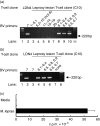Functional characterization of a T-cell receptor BV6+ T-cell clone derived from a leprosy lesion
- PMID: 17140401
- PMCID: PMC2265884
- DOI: 10.1111/j.1365-2567.2006.02510.x
Functional characterization of a T-cell receptor BV6+ T-cell clone derived from a leprosy lesion
Abstract
Human infection with Mycobacterium leprae, an intracellular bacterium, presents as a clinical and immunological spectrum; thus leprosy provides an opportunity to investigate mechanisms of T-cell responsiveness to a microbial pathogen. Analysis of the T-cell receptor (TCR) repertoire in leprosy lesions revealed that TCR BV6(+) T cells containing a conserved CDR3 motif are over-represented in lesions from patients with the localized form of the disease. Here, we derived a T-cell clone from a leprosy lesion that expressed TCR BV6 and the conserved CDR3 sequence L-S-G. This T-cell clone produced a T helper type 1 cytokine pattern, directly lysed M. leprae-pulsed antigen-presenting cells by the granule exocytosis pathway, and expressed the antimicrobial protein granulysin. BV6(+) T cells may therefore functionally contribute to the cell-mediated immune response against M. leprae.
Figures




References
-
- Leprosy. Global situation. Wkly Epidemiol Rec. 2002;77:1–8. - PubMed
-
- Salgame P, Abrams JS, Clayberger C, Goldstein H, Convit J, Modlin RL, Bloom BR. Differing lymphokine profiles of functional subsets of human CD4 and CD8 T cell clones. Science. 1991;254:279–82. - PubMed
-
- Yamamura M, Uyemura K, Deans RJ, Weinberg K, Rea TH, Bloom BR, Modlin RL. Defining protective responses to pathogens: cytokine profiles in leprosy lesions. Science. 1991;254:277–9. - PubMed
-
- Wang X, Golkar L, Uyemura K, et al. T cells bearing Vβ6 T-cell receptors in the cell-mediated immune response to Mycobacterium leprae. J Immunol. 1993;151:7105–16. - PubMed
Publication types
MeSH terms
Substances
Grants and funding
LinkOut - more resources
Full Text Sources
Medical

